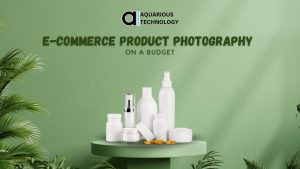E-commerce Product Photography on a Budget

In the fast-paced world of e-commerce, captivating product photography is crucial for attracting potential customers and making sales. High-quality images can significantly impact your online store’s credibility and conversion rates. However, for small businesses on a tight budget, hiring professional photographers or investing in expensive equipment might not be feasible. The good news is that you can still achieve stunning product photography without breaking the bank. In this article, we’ll explore top tips on how to do e-commerce product photography on a budget.
Why Does Good E-commerce Product Photography Matter?
Effective e-commerce product photography is more than just a visual representation of your items. It’s a critical element that can make or break your online business. Here are some compelling reasons why investing time and effort into good product photography is essential:
First Impressions Count:
Your product photos are often the first things potential customers see when they visit your online store. A well-executed image can captivate a visitor’s attention, encouraging them to explore your offerings further. Conversely, poor-quality photos can give a negative first impression and cause potential buyers to leave your site.
Builds Trust:
High-quality product images convey professionalism and trustworthiness. Customers are more likely to trust a business that presents its products in a clear, appealing, and honest manner. Quality photography can help bridge the gap between online shopping and the tactile experience of in-person shopping.
Enhances Brand Identity:
Consistent and well-thought-out product imagery contributes to your brand’s identity. It helps convey your brand’s personality, values, and aesthetics. Customers should instantly recognize your products through your distinctive visual style.
Boosts Conversions:
Good product photography directly impacts conversion rates. When customers can see your products clearly and in detail, they feel more confident in making a purchase decision. High-quality images can reduce doubts and hesitation, leading to more sales.
Reduces Returns:
Detailed and accurate product images leave less room for misunderstanding. When customers receive the product that closely matches their expectations, the likelihood of returns due to misrepresentation decreases, saving both you and your customers time and money.
Competitive Advantage:
In the crowded e-commerce landscape, standing out is vital. High-quality product photography sets you apart from competitors with subpar visuals. It can become a unique selling point that attracts and retains customers.
Better SEO and Visibility:
Search engines favor websites with visually engaging content. Optimizing your product images with relevant alt text and file names can improve your website’s search engine ranking, making it easier for potential customers to find your products.
Social Media Sharing:
Good product photos are highly shareable on social media platforms. When customers share your images, they effectively become brand advocates, exposing your products to a broader audience and potentially leading to organic growth.
Increased Customer Engagement:
Compelling images not only showcase your products but also tell a story. They engage customers emotionally, allowing them to imagine how the product fits into their lives. This engagement can lead to more time spent on your website and a greater likelihood of conversion.
Positive Reviews and Referrals:
When customers are delighted with their purchase, they are more likely to leave positive reviews and recommend your products to friends and family. Stunning product photography plays a role in creating this positive experience.
Photography Tips for Small Businesses
Plan Your Shoot
Before diving into photography, it’s essential to have a well-thought-out plan. Determine the look and feel you want for your product images. Consider factors such as lighting, background, and composition. Planning ahead can save you time and resources in the long run.
Use Natural Light
Natural light is a cost-effective way to achieve excellent product photos. Set up your shoot near a large window or outdoors, but avoid direct sunlight, as it can create harsh shadows. Overcast days provide soft, diffused light, ideal for product photography. You can also use sheer curtains or white bedsheets to diffuse light further.
DIY Lightbox
If you need more control over lighting, consider creating a DIY lightbox. All you need are some white cardboard, a box, and a few desk lamps. Cut out windows in the box and cover them with white paper or cloth to diffuse the light. Place your product inside the box and position the lamps outside to illuminate it evenly. This simple setup can produce professional-looking results.
Camera and Tripod
While a high-end camera is ideal, you can achieve decent results with a smartphone or a basic digital camera. The key is stability. Use a tripod or any stable surface to prevent camera shake, ensuring sharp and clear images. If you’re using a smartphone, you can invest in a smartphone tripod mount to attach it securely.
Master Composition
Composition plays a significant role in product photography. Learn about the rule of thirds, leading lines, and framing to create visually appealing images. Experiment with different angles and perspectives to find what works best for your products. Don’t be afraid to crop and edit your photos to improve composition during post-processing.
Keep It Simple
A cluttered background can distract from your product. Use plain backgrounds like white or solid colours, or opt for a textured surface like wood or fabric that complements your product. Ensure the background is clean and free from distractions. You can easily achieve this by using a backdrop or a piece of paper.
Product Styling
Pay attention to how you style your products. Clean and well-maintained products look more appealing. Use props sparingly to enhance your product’s story and add context. For example, if you’re selling kitchenware, consider placing ingredients or utensils alongside your product to show how it’s used.
Editing Software
Post-processing is essential to refine your product images. While Adobe Photoshop and Lightroom are industry-standard tools, you can achieve excellent results with free or more affordable alternatives like GIMP, Canva, or Pixlr. Adjust brightness, contrast, and color balance to make your images pop.
Consistency
Maintain consistency across your product photos. Use the same lighting setup, camera settings, and composition for all your products. This consistency not only provides a professional look but also helps customers navigate your website more easily.
Online Tutorials and Courses
There are countless online resources and courses available that can help you improve your product photography skills on a budget. Websites like YouTube and Skillshare offer a plethora of tutorials and classes taught by professionals. Invest time in learning new techniques and refining your skills.
Invest in Basic Equipment
While we’re focusing on budget-friendly tips, investing in some essential equipment can make a significant difference. Consider purchasing a basic photography lighting kit or a reflector to control and enhance the lighting. These relatively inexpensive items can elevate your product photography game.
Practice Makes Perfect
The more you practice, the better you’ll become at product photography. Take test shots, review your work critically, and make adjustments accordingly. Over time, your skills will improve, and you’ll be able to capture product images that truly stand out.
How to Take Great Product Photos
Now that we understand the importance of good e-commerce product photography, let’s dive into the practical steps for capturing stunning product images on a budget:
Set Up Your Space:
Choose a well-lit area with access to natural light if possible. Position your product near a window or outdoors, avoiding direct sunlight. If natural light isn’t available or consistent, create a DIY lightbox using desk lamps and white sheets of cardboard to diffuse the light.
Use a Tripod:
Stability is crucial for sharp and clear images. Use a tripod to keep your camera or smartphone steady. If using a smartphone, consider investing in a smartphone tripod mount for added stability.
Select the Right Camera:
While a DSLR camera is ideal, modern smartphones often have excellent cameras. Use the highest resolution setting available on your camera or smartphone to capture detailed images.
Set Up Your Product:
Clean and prepare your product for photography. Ensure it’s free from dust, fingerprints, and smudges. If necessary, use props or styling elements to add context and appeal to your shots.
Compose Your Shot:
Pay attention to composition. Experiment with different angles, perspectives, and framing to find the most visually appealing arrangement for your product. Apply basic composition rules like the rule of thirds and leading lines.
Adjust Your Camera Settings:
If using a camera, set your camera to manual mode if possible. Adjust settings such as aperture, shutter speed, and ISO to control exposure and depth of field. If using a smartphone, explore manual camera apps that allow for more control.
Focus:
Ensure your product is in sharp focus. Most cameras and smartphones offer auto-focus capabilities, but you can also tap on the screen to manually adjust the focus point.
Take Multiple Shots:
Capture multiple shots of the same product from various angles and distances. This gives you options during the editing phase and ensures you have a variety of images to choose from.
Edit and Enhance:
After capturing your images, use photo editing software to enhance them further. Adjust brightness, contrast, color balance, and sharpness. Crop and straighten your images if needed. Be sure to maintain consistency across all product images for a professional look.
Resize and Optimize:
Resize your images to fit your website’s specifications, typically around 1200-2000 pixels on the longest side for web use. Optimize them for the web by compressing them without compromising quality to ensure faster loading times.
Save and Backup:
Save your edited images in a safe and organized manner. Consider using cloud storage or external hard drives for backup to prevent any loss of your valuable product photos.
Regularly Update:
As your product lineup changes or evolves, make sure to update your product photos accordingly. Maintain a fresh and consistent look across your e-commerce site.
Conclusion
E-commerce product photography on a budget is not only achievable but can also yield impressive results. With careful planning, creativity, and the right techniques, small businesses can create captivating product images that attract customers and boost sales. Remember to leverage natural light, DIY setups, and free or affordable editing tools to keep costs low while maintaining the quality of your product photos. Consistency, practice, and a willingness to learn are your best allies on the path to mastering budget-friendly e-commerce product photography. So, grab your camera, set up your makeshift studio, and start capturing stunning product images that will help your small business thrive in the competitive world of online retail.
-
14
+Category
-
98
+Post
Top Categories
Popular Posts
- The Power of Prototyping in Software Development
- Version Control Best Practices for App Development
- Understanding Visual Hierarchy: A Guide to Effective Design
- Crafting Intuitive Navigation: A Guide to Seamless User Experience
- Choose Your Best Cloud Provider
- Making the Leap: Transitioning from Manual to Automated Software Testing
- Using GitHub- Advantages and Disadvantages
- E-commerce Product Photography on a Budget
- Tech Innovation in Developing Countries
- Smart Cities: How Technology is Shaping the Urban Landscape
- Principles of Composition: Creating Visual Harmony with Composition
- Exploring Cross-Platform App Development
- Why Regular Website Updates Matter
- Navigating Effective Facebook Audience Targeting
- Implementing Ads for Game Monetization
- Designing User-Centric Mental Health Apps: Enhancing Well-being in the Digital Age
- NFTs and Collectibles: Creating NFT App Solutions for Collectors and Enthusiasts
- Successful Implementation of Enterprise Apps
- Maximizing Business Impact with EQ
- Proven SMO Ads Optimization Tips (2023)






